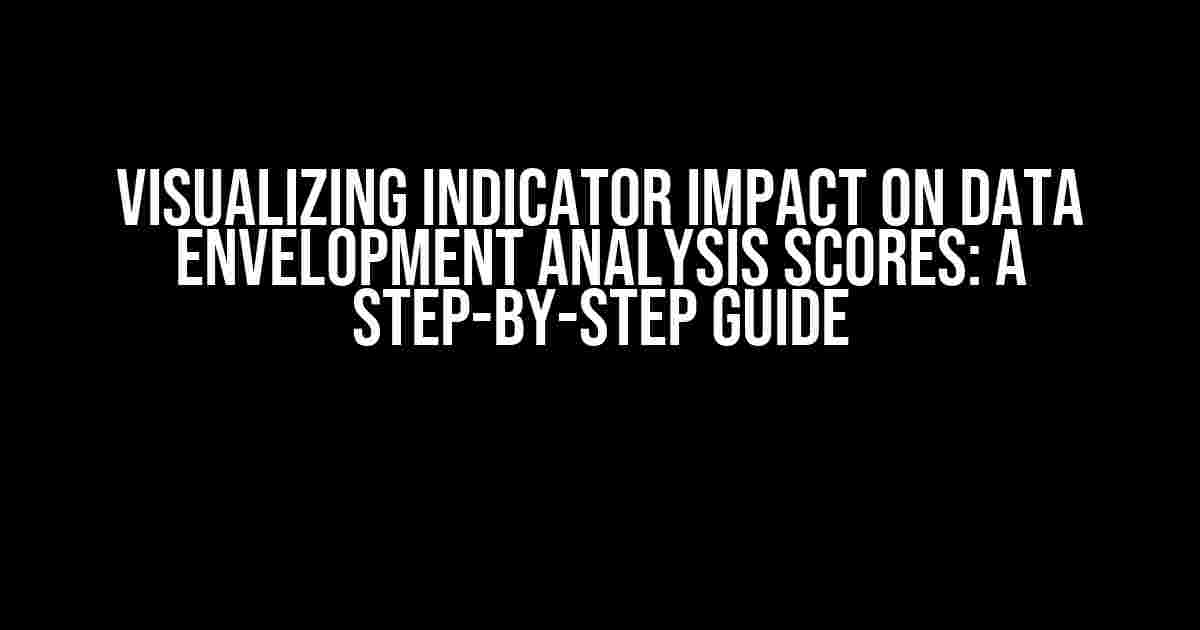Data Envelopment Analysis (DEA) is a powerful tool for evaluating the performance of decision-making units (DMUs) based on multiple inputs and outputs. However, understanding the impact of individual indicators on DEA scores can be a daunting task. In this article, we will explore the importance of visualizing indicator impact on DEA scores and provide a step-by-step guide on how to do it.
Why Visualize Indicator Impact on DEA Scores?
DEA scores provide a comprehensive measure of a DMU’s performance, but they can be difficult to interpret without understanding the underlying drivers of the scores. Visualizing the impact of individual indicators on DEA scores can help you:
- Identify key performance indicators (KPIs) that are driving the DEA scores
- Understand the relationships between different indicators and DEA scores
- Isolate areas for improvement and optimize resource allocation
- Communicate DEA results more effectively to stakeholders
Step 1: Prepare Your Data
To visualize the impact of indicators on DEA scores, you’ll need a dataset with the following characteristics:
- Multiple inputs and outputs for each DMU
- A DEA score calculated for each DMU
- Each input and output should have a unique identifier
Here’s an example of what your dataset might look like:
| DMU | Input 1 | Input 2 | Output 1 | Output 2 | DEA Score |
|---|---|---|---|---|---|
| A | 10 | 20 | 30 | 40 | 0.8 |
| B | 15 | 25 | 35 | 45 | 0.9 |
| C | 12 | 22 | 32 | 42 | 0.85 |
Step 2: Calculate Partial DEA Scores
Partial DEA scores measure the impact of individual indicators on the overall DEA score. You can calculate partial DEA scores using the following formula:
Partial DEA Score = (DEA Score * Input/Output Weight) / (Sum of Input/Output Weights)Where:
- DEA Score is the overall DEA score for the DMU
- Input/Output Weight is the weight assigned to the input or output in the DEA model
- Sum of Input/Output Weights is the sum of all input and output weights in the DEA model
Calculate partial DEA scores for each input and output indicator. This will give you a dataset with the following structure:
| DMU | Input 1 Partial Score | Input 2 Partial Score | Output 1 Partial Score | Output 2 Partial Score |
|---|---|---|---|---|
| A | 0.3 | 0.2 | 0.4 | 0.1 |
| B | 0.35 | 0.25 | 0.45 | 0.15 |
| C | 0.32 | 0.22 | 0.42 | 0.12 |
Step 3: Visualize the Partial DEA Scores
Visualizing the partial DEA scores can help you identify patterns and relationships between the indicators and DEA scores. You can use a variety of visualization tools, such as:
- Bar charts to compare partial scores across different indicators
- Scatter plots to visualize the relationships between partial scores and DEA scores
- Heatmaps to identify correlations between different indicators
Here’s an example of a bar chart showing the partial DEA scores for each indicator:
<!-- Insert bar chart code here -->Step 4: Analyze and Interpret the Results
Once you’ve visualized the partial DEA scores, you can analyze and interpret the results. Look for:
- Indicators with high partial scores, indicating a strong impact on DEA scores
- Indicators with low partial scores, indicating a weak impact on DEA scores
- Correlations between different indicators and DEA scores
Based on your analysis, you can:
- Identify areas for improvement and optimize resource allocation
- Communicate DEA results more effectively to stakeholders
- Refine your DEA model to better capture the underlying relationships between indicators
Conclusion
Visualizing the impact of individual indicators on DEA scores is a powerful way to gain insights into the underlying drivers of performance. By following the steps outlined in this article, you can:
- Calculate partial DEA scores for each indicator
- Visualize the partial scores using a variety of visualization tools
- Analyze and interpret the results to identify areas for improvement
By taking these steps, you can unlock the full potential of DEA and make data-driven decisions to drive performance improvement.
Additional Resources
For more information on DEA and visualizing indicator impact, check out the following resources:
- DEA Software: A comprehensive review of DEA software packages
- Data Envelopment Analysis: A primer on DEA and its applications
- Visualization Tools: A guide to visualization tools for data analysis
Happy visualizing!
Frequently Asked Question
Get the inside scoop on Visualizing indicator impact on Data Envelopment Analysis scores!
What is the main goal of visualizing indicator impact on DEA scores?
The primary goal of visualizing indicator impact on DEA scores is to identify the most influential indicators that drive the efficiency scores of Decision-Making Units (DMUs). This helps analysts to pinpoint areas that require improvement and optimize resource allocation.
How does visualizing indicator impact on DEA scores help in performance benchmarking?
By visualizing the impact of indicators on DEA scores, organizations can identify best-practice DMUs and benchmark their performance against peer groups. This facilitates the sharing of best practices, resource allocation, and strategic planning.
What types of visualizations are commonly used to display indicator impact on DEA scores?
Common visualization techniques used to display indicator impact on DEA scores include bar charts, scatter plots, and radar charts. These visualizations help analysts to quickly identify patterns, trends, and correlations between indicators and DEA scores.
How can visualizing indicator impact on DEA scores support decision-making?
By providing a clear understanding of the relationships between indicators and DEA scores, visualizations can inform strategic decisions related to resource allocation, process improvement, and policy development. This enables decision-makers to make data-driven decisions that drive efficiency and performance.
Can visualizing indicator impact on DEA scores be used for sensitivity analysis?
Yes, visualizing indicator impact on DEA scores is an effective way to conduct sensitivity analysis. By analyzing how changes in indicator values affect DEA scores, analysts can identify the most sensitive indicators and assess the robustness of their results.


